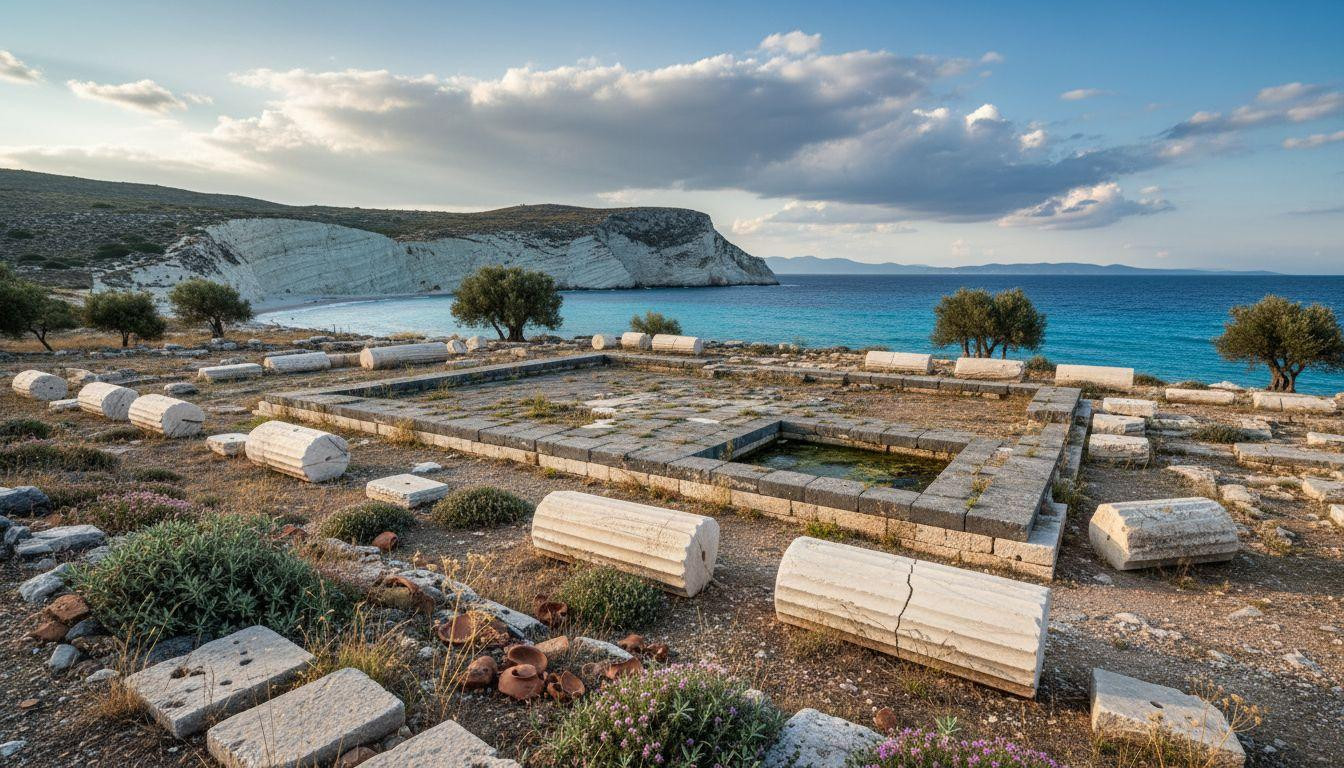Morning sunlight pierces through Aegean mist as the ferry from Paros cuts toward Antiparos. Most passengers crane toward the white-washed villages ahead. Yet 700 meters southwest, barely visible through the crystalline water, an uninhabited island rises from turquoise depths. Its ancient Doric columns catch golden light while tourists sleep in their hotels.
This is Despotiko, the Cyclades’ most significant archaeological sanctuary that mass tourism forgot. For 25 years, systematic excavations have revealed treasures rivaling famous Delos. The difference? Zero entrance fees, zero crowds, zero commercial infrastructure.
Where Apollo’s forgotten sanctuary waits across 2,300 feet of Aegean blue
Despotiko sits precisely at GPS coordinates 36°58′N 25°00′E, administratively part of Antiparos in the Paros municipality. The island spans just 2.9 square miles with a highest elevation of 614 feet. White limestone cliffs contrast sharply with deep Cycladic blue water.
Access requires private boat charter from three departure points. Agios Georgios beach on Antiparos offers the shortest crossing at just 700 meters. Kastro port provides more boat options but takes 10 minutes. Pounta on Paros adds ferry connections but extends the journey.
No regular ferries serve Despotiko. No hotels exist. No tavernas operate. This island of 2,500 where 365 churches rise between Santorini and party beaches demonstrates how neighboring Cycladic islands balance tourism differently.
Charter costs range from $35-50 per person for group tours. Private boats cost $120-150 for six passengers. Journey time averages 7-10 minutes from Antiparos depending on departure point.
The sanctuary that rivals Delos but costs nothing
Archaeological excavations since 1997 have uncovered one of Greece’s richest ancient sanctuaries. The site was dedicated to Apollo and active from the 9th century BC through Roman times. Recent discoveries suggest it may have exceeded Delos in religious importance during the Archaic period.
What makes this sacred ground exceptional
Unlike Delos with its $15 entrance fee and 350,000 annual visitors, Despotiko remains genuinely untouched. The main temple measures 54 by 39 feet with two inner chambers and a marble-block lobby. Excavations have revealed a sophisticated water management system including a main tank measuring 25 by 18 feet.
The “Hestias Isthmias” inscription provides crucial evidence of ancient geography. When carved, sea levels were 10 feet lower. An isthmus likely connected Despotiko to Antiparos until Hellenistic times, explaining the sanctuary’s strategic importance.
The visual poetry of abandoned worship
White marble columns glow against impossible Aegean blue. Ancient stone blocks rest where earthquakes scattered them centuries ago. Wild thyme and sage grow between temple foundations. The intimate 2.9-square-mile scale feels walkable and contemplative.
Forget Delos, this sacred island has ancient ruins and turquoise beaches with zero crowds offers comparison with nearby Rineia, another overlooked archaeological sanctuary.
Experiencing Despotiko’s archaeological solitude
Most visitors charter boats from Agios Georgios beach where local fishermen know the calm southern bay. Landing on silver-golden sand, you’re often completely alone except for occasional archaeological teams during excavation seasons.
Walking among the ruins
The main sanctuary complex spreads across the island’s center. Doric column drums lie scattered where ancient earthquakes toppled them. Foundation walls trace precise temple layouts. Pottery sherds glint in afternoon Mediterranean sun.
Archaeologists work seasonally from April through October. September offers fascinating but restricted excavation areas. November through March provides complete solitude with ruins accessible for contemplation. No fences block access to most areas.
The view from Antiparos cliffs
Many visitors never land, simply contemplating Despotiko from Antiparos western cliffs. Sunset transforms temple ruins amber while Aegean water deepens to indigo. Local tavernas in Agios Georgios serve fresh octopus ($22) and island wine ($8/glass) while you watch light change across the sanctuary.
Forget Santorini, this Cycladic island has the same golden light and costs 82% less showcases Iraklia, another budget-friendly Cycladic alternative with authentic character.
Why Delos gets crowds while Despotiko gets reverence
Delos attracts over 350,000 annual visitors, requires advance booking, and prohibits overnight stays. Despotiko receives perhaps 1,000 curious souls yearly. Most are archaeologists, Greek history enthusiasts, or sailors anchoring in the protected southern bay.
There’s ethical beauty in visiting significance without spectacle. Despotiko doesn’t need tourism revenue to matter. The sanctuary’s importance remains academic, not commercial. Your presence adds nothing, takes nothing from the ancient stones and Mediterranean silence.
This represents what archaeological sites offered before monetization: pure encounter with human stories etched in marble and memory.
Your Questions About Despotiko answered
How do I actually visit this uninhabited island?
Base yourself in Antiparos with accommodations from $75-200/night. Arrange boat charters through hotels or directly at Agios Georgios beach. May through October offers reliable weather and calm seas. November through March requires weather flexibility but rewards with absolute solitude.
Is there any infrastructure or just ruins?
Zero infrastructure exists. Bring water, sun protection, and sturdy shoes for rocky terrain. No shade except scattered olive trees. The archaeological site remains unfenced but active excavations mark restricted areas with yellow tape during work seasons.
How does it compare to other Cycladic archaeological sites?
Archaeological significance rivals Delos while tourist development resembles pristine wilderness. 7 Greek islands that rival Santorini’s beauty at half the price and zero crowds provides broader context for exploring authentic Cycladic alternatives. If you found Delos commercialized, Despotiko offers the opposite extreme.
As your chartered boat returns to Antiparos at dusk, Despotiko’s temple columns fade into purple twilight. The sanctuary that once welcomed Bronze Age sailors bearing offerings to Apollo now welcomes only wind, waves, and occasional reverent visitors. Some sacred places don’t need development. They need remembrance.
